
| EMAIL THIS PAGE TO PALS |
Texas, 4th - 19th April 2002
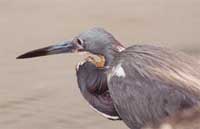
A personal account by Chris Galvin
Participants: Stephen Branch, Neil Cowley, Patricia Eaves, Chris Galvin, Trevor Hardiman, Barry and Marion Hart, Margaret Hodge, Eric Holmes, Alan Humphreys, Martin Jaggers, Peter and Irene Knight, Stephen Moore, Tony Morris, Jim Wakenshaw, Leaders: Vaughan Ashby, Peter Basterfield
This is my personal account of the birds and experiences I had as a participant in the Birdfinders tour of Texas 4th-19th April 2002. The birds recorded are only the birds that I saw and not that of the group. All opinions expressed in this report are attributable to me alone. All photographs by and copyright © Chris Galvin.
Day 1: We met at London Gatwick for the 10.30 Continental Airlines flight to Houston and experienced no delays. As we were landing at Houston some of the group were looking out of the windows of the plane to spot the first bird of the trip. A Snowy Egret in a drainage ditch alongside the taxiway had the honour. It was later claimed that one of the group had seen a Turkey Vulture sitting on the terminal building. On the forecourt of the vehicle rental office I noticed a bird perched on top of a telegraph pole. It was pointed out to us that this was a Northern Mockingbird and we would soon tire of this bird. There was never a truer statement uttered. Mockingbirds would later prove to be everywhere and mistaken for all sorts of other birds. We then loaded two 15-seat passenger vans and headed for Victoria before the Houston rush hour started. We stopped en route at a diner to find a Killdeer in the car park and Scissor-tailed Flycatchers on the wires and an Upland Sandpiper in an adjacent field, whilst Purple Martins buzzed around our heads in the fading light.
Day 2: The second day meant an early start and our first taste of the leaders favourite, "Whataburger" later nicknamed as "What-a-bugger" because of the all too frequent visits by the group for breakfast. The early start was not to taste the dubious qualities of "Whataburger" but for the drive south to Rockport and to catch a boat for a trip out to the barrier islands for Whooping Crane. Before reaching Rockport we stopped at Copano Bay. Here we found Lesser and Greater Scaup side by side, Piping Plover and Wilson's Plover and an American Oystercatcher. However our first "real rarity" was Purple Sandpiper (well it's rare in Texas). The group enjoyed superb views of an Osprey perched on a wooden bridge eating a fish. The same bridge also had a perched Belted Kingfisher, whilst Caspian and Forster's Terns fished the bay. At Rockport, whilst we were waiting to board the boat, we watched Snowy and Great Egrets, Great Blue Heron and Laughing Gulls on the quay stealing prawns and scraps from the fishermen's nets. On our 40 minute trip out to the islands to see the Whooping Cranes we counted 30 Great Northern Divers (Common Loons) in a variety of plumages as well as Eared Grebe, Least and Royal Terns. Dolphins also swam in the wake of the boat. Before reaching the cranes we had great views of Redhead and Bufflehead. Without a doubt the highlight of the boat trip was the Whooping Cranes; we counted 29 in all .We counted three groups of 2 and eight family groups of 3 birds. The boat was able to get us within 30 yards of two of the family groups and we watched the birds feed on crabs. Everybody agreed that it had been worth the extra effort for the early start to see so many of one of the world's rarest birds.

Also seen flying along the islands was Crested Caracara and some of the group saw a Racoon on the shoreline. Distant scope views were had of Seaside Sparrow too. After the boat trip we spent some time exploring the marina and shoreline of Rockport. Amongst the Royal and Forster's terns there were two Sandwich Terns that were in full breeding plumage and had a pink wash on the breast. We were also able to witness the incredible sight of Black Skimmers skimming the surface of the sea whilst across the road was the skimmer colony that allowed very close approach. From the marina itself another Osprey fished and on the island were several Reddish Egrets and Black-crowned Night-herons, along with Little Blue, Tricolored, and Great Blue Herons. The marina also produced Blue-winged Teal, Pied-billed Grebe and Canvasback. Returning to Victoria, we again stopped at Copano Bay where, in addition to the birds present in the morning, we had a summer-plumaged Spotted Sandpiper as well as Savannah Sparrow and Greater Yellowlegs. Today had seen me add 51 new birds to my list. Not a bad start.
Whilst on the boat the weather was warm and overcast and windy. These conditions fooled everyone on the trip and we all appeared at dinner that evening with lobster-red faces. A valuable lesson had been learned and everybody carried sun creams with them from then onwards. Several of the group wanted to celebrate seeing the Whooping Cranes with a nice cool beer or glass of wine with dinner. Imagine our dismay when we were informed whilst ordering our dinner "This is a family restaurant. We don't serve liquor here. If you want to get drunk then I can give you the name of a bar to go to!" God Bless America! Another valuable lesson had been learned and at all future overnight stops scouts were sent out into the neighbourhood to find licensed restaurants.

Day 3: An early start to our day to get to Aransas National Wildlife Refuge. During the trip to Aransas Margaret spotted a Wild Turkey in brush alongside the road, despite their size Wild Turkeys would prove to be a difficult bird to locate during the whole trip. So many birds would be located whilst driving in the vans. A fact not ignored by Jim Wakenshaw, who coined the phrase "High-speed birding". At Aransas it was decided that we would not go around the motor trail but explore some of the footpaths and trails. Prothonotary Warbler, Tennessee Warbler, Red-eyed Vireo and Northern Waterthrush were found within minutes of us getting out of the vans. A personal highlight for me was to see my first ever hummers: 3 Buff-bellied and 2 Ruby-throated Hummingbirds were added to the list. Golden-fronted and Ladder-backed Woodpeckers and Common Yellowthroat were also present. It was at Aransas that we had the first rain of the trip and this was to prove almost fatal for Alan's camera lens. Alan did not cover up his lens in the rain and this led to the lens steaming up with condensation. The lens would be out of action for some days to come whilst it dried out. We moved on to Goose Island State Park It was here that we saw our first Bobcat of the tour. Whilst the group were looking at a mixed group of Indigo Bunting and Orchard Oriole I looked back along the road. A Bobcat was stood in the road looking back at us peering into the bushes. As I called out the cat sauntered back into the thick undergrowth. The rain had brought down a number of warblers and orioles and we took our time searching through the group. Another Tennessee Warbler and 3 more Prothonotary Warblers and White-eyed and Warbling Vireos were found. A nice sight was of a female Merlin perched on an overhead power line. The day also produced Lincoln's and White-throated Sparrows, Inca Dove and Common Ground-dove, Eastern Kingbird, Eastern Meadowlark, Black-bellied Whistling-duck, Wilson's Snipe and Blue-gray Gnatcatcher. Blue-gray Gnatcatcher was to give some of the group (particularly Pat) some fun as we played with the name and gave it a rather ruder alternative. Other birds were to receive the same treatment later in the tour.
Day 4: An early start to the day for the long trip south to McAllen, birding on the way. A roadside pool proved to be a fruitful place to stop as we found Long-billed Dowitcher, Pectoral Sandpiper, Greater and Lesser Yellowlegs, Gadwall, Green-winged Teal, American Wigeon, Ruddy Duck and Fulvous Whistling-duck. Later we stopped at a copse that bordered the highway near the rest stop at Sarita. We connected with both Tropical and Northern Parula and the entire group had fantastic views. Summer Tanager was seen and the first Black-crested Titmouse of the trip as well as Nashville Warbler put in an appearance. We spent some time at the Sarita rest stop slowly searching through the trees for more warblers. Somewhat disconcerting though was the sign that warned "Beware of Snakes". A flock of Northern Rough-winged Swallows fed overhead as we peered into the trees. Feeding in the tree tops were Orange-crowned, Yellow-rumped and Nashville Warblers. As we again headed south more high-speed birding enabled us to tick off Sharp-shinned Hawk, Northern Harrier as well as connecting with Chimney Swift. Brewer's Blackbirds gave themselves up and were seen feeding on the front lawn of a house as we got closer to Sabal Palms. The afternoon was spent at the National Audubon Society's Sabal Palms reserve. This sanctuary was to prove to be a photographer's dream. Immediately next to the reserve centre was a feeding station. Attracted to the feeders were Olive Sparrow, the fantastically-coloured Green Jay, Black-crested Titmouse, Long-billed Thrasher, White-tipped Dove, and Buff-bellied and Ruby-throated Hummingbirds. Golden-fronted Woodpeckers and Hooded Orioles vied for best position on the citrus fruits provided by the reserve staff. Largest birds at the feeding station were the pheasant-sized Plain Chachalacas. Alan and I stayed near the reserve centre continuing to photograph at the feeding station whilst the rest of the group walked the trails. A Louisiana Waterthrush and Least Grebe were seen on the pool as well as our first Great Kiskadee of the trip. Finally Alan and I went to look for the rest of the group when we experienced a "mini fall" of warblers in a field alongside one of the trails. A mixed feeding flock of Black-and-white, Hooded and Yellow-throated Warblers came very close to where we were stood. It was whilst searching through this flock that we also saw an Eastern Towhee. Before leaving Sabal Palms we were also rewarded with excellent views of Altamira and Baltimore Orioles, Couch's and Western Kingbirds as well as Brown-crested Flycatcher. Our next stop was the airport near Brownsville to search for the Tamaulipas Crow: this, however, was a fruitless search but we did connect with Chihuahuan Raven. When we arrived at our motel for the evening we agreed that the day had been exhausting but very rewarding. The next day was to be spent at Bentsen State Park, which was about 20 minutes drive away and did not mean an early start to the day. To celebrate, several of the group joined with Alan and I with a cool beer and a very nice Italian meal at the Olive Press Restaurant near the motel; we all wobbled home.
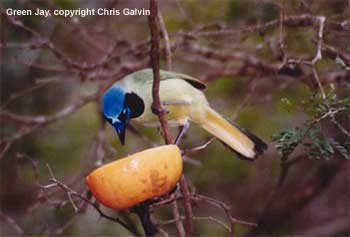
Day 5: Some of us we were thankful that the day started somewhat later today for the short drive to Bentsen State Park. This is essentially a trailer park. We were to stay most of the day here walking the trails and leisurely checking the feeding stations that are set up by the people who spend a large part of the winter here. Number one target for the day was Clay-colored Robin. One individual immediately surrendered and gave itself up as soon as we alighted from the vans. "Why can't birding be this easy at home?" some of us muttered. Indigo Buntings were everywhere in the shrubbery along with Bronzed Cowbirds but an added bonus was finding an obliging Lazuli Bunting. As the temperature started to rise so did the raptors. Our first Hook-billed Kite was seen before lunch and we saw Cooper's, Broad-winged and Sharp-shinned Hawks above the trailer park. We spent lunchtime at the nearby Anzalduas. Here we were able to get great scope views of Gray Hawk on the nest. We ate our lunch at some picnic tables located in the shade of some trees, these very same trees later provided us with the colourful extravaganza of a stonking Black-throated Green Warbler - Phylloscopus warblers Pah! We were to return back to McAllen for an early meal before returning to Bentsen in the evening for some nighttime birding. As we left Anzalduas we were rewarded with our first views of Roadrunner - "meep meep!" The bird performed for us by giving a display of its amazing speed as it whirred around the field. We returned to Bentsen in the evening with our long-sleeved shirts, trousers and hats, armed to the teeth with mozzie spray. Elf Owl was seen at the nest hole near the toilet block and later an Eastern Screech-owl flew over us. Up to seven Lesser Nighthawks were seen hawking over us as dusk approached. The best views of Elf Owl were had in the complete darkness as Vaughan "captured" one with his high-power hand-held searchlight. This searchlight was later instrumental in giving us brief views of our one and only Common Pauraque of the trip.
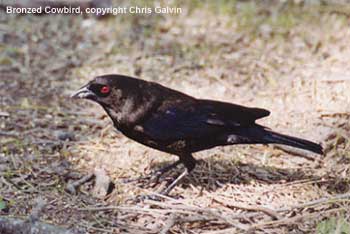
Day 6: The day was to be spent at the Santa Ana National Wildlife Refuge, if of course Vaughan could find the way. Of all things, we experienced fog early in the morning and at first could not navigate our way to Santa Ana. During our "Magical Mystery Tour" we did find some groups of waders in flooded fields close to the Rio Grande that included American Golden Plover, (this caused some concern as we first saw this disappearing into the mist and it was provisionally identified as Mountain Plover by me - doh). Solitary Sandpiper, Semi-palmated Sandpiper and Long-billed Dowitcher were also seen in the mist. Eventually we back-tracked on ourselves and "found" Santa Ana. Near to the reception of the reserve are several hummingbird feeders and both Buff-bellied and Ruby-throated Hummingbirds were frequenting these. The birds were buzzing in every few minutes to feed on the sugar/water solution and were giving excellent photo opportunities. As I tried to get closer and settle in for a photo shoot disaster struck. I opened up the legs of my Manfrotto 440 carbon fibre tripod, and as I did, a leg broke off the tripod at the collar. Paying so much money for the tripod only 18 months earlier I certainly expected a higher build quality. This event put me under a cloud for the rest of the day as I had a quiet sulk. I did however manage to get the picture below of a Buff-bellied Hummingbird even with the broken tripod.
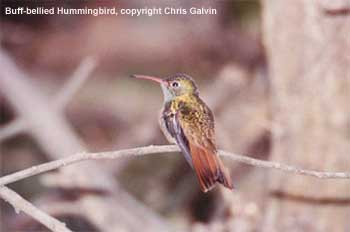
The day did get better though. The trails around Santa Ana produced excellent views of Least Grebe. A new hide had recently been built on the reserve and was of an excellent standard, apart from the fact that the viewing slots were installed vertically instead of horizontally!!!! Much better views of Eastern Screech-owl were also had today as well as House Wren and White-tailed Kite. As the group were shepherded back to the car park we were treated to the extraordinary sight of 2 Harris's Hawks sitting above us on a radio pylon. On the way back to McAllen we stopped off at McAllen sewage works. Another tick on my "sewage works of the world I have visited" list. This was a truly worthwhile detour. The first sight was of a mixed flock of hundreds of waders consisting of Semi-palmated, Western, Least, Stilt, Baird's, Pectoral and Solitary Sandpipers, Greater and Lesser Yellowlegs, and Long-billed Dowitcher. All in summer plumage and very close views. No distant brief views of first-winter birds on a windy and cold mudflat here. Just when you think it does not get better we were treated to 3 Wilson's Phalaropes; this certainly brought me out of my sulk. Next stop Wal-Mart for a new tripod. After the visit to Wal-Mart we had a quick meal before going out into the suburbs of McAllen to look for roosting parrots. We visited two areas that have become regular roosting areas for parrots. We did not see any Green Parakeet but did connect with 43 Red-crowned Parrots and 2 Yellow-headed Parrots.
Day 7: Today was to be the first of two long days on the road and we had to be on the road early to arrive at Salineño on the Rio Grande shortly after dawn. This was to be THE place for the Mexican specialities and totally lived up to all of our expectations. In very short order we had bagged Brown Jay, Great Horned Owl, Ringed Kingfisher, Muscovy Duck, (Peter's only lifer of the trip), Mexican Duck and Cinnamon Teal. The latter being a female and a startling male feeding near the shore of an island on the USA side of the border so it could be ticked. Red-billed Pigeon took a lot more effort to find and then we got only distant but tickable views. We were not fortunate enough to get Green Kingfisher here, but did get superb views of singing Marsh Wren and a Spotted Sandpiper was extremely approachable on the Rio Grande. This bird had not yet come into summer plumage and was very useful as a photo reference for the differences between it and Common Sandpiper. We moved on to Falcon State Park where Lark Sparrows were very abundant in the short scrubby grass near Falcon Dam and Osprey fished on the Rio Grande. This was the hottest day of the trip and we walked along a track that got us closer to the river. Our target bird here was the Green Kingfisher that we had missed at Salineño. We found a viewpoint across the Rio Grande, sat and waited. I dozed off only to be awoken with cries of "Green Kingfisher!" I lifted my bins off my chest and instantly saw the bird flying right to left along the river. We were treated to two birds some minutes later as they flew directly towards us. Excellent. The walk back to the vans was rewarded with superb views of Verdin at a nest site. More "high-speed birding" ensued as we headed towards Laredo. Red-shouldered Hawk, Black-throated Sparrow, Ash-throated Flycatcher and Curved-billed Thrasher and the odd plumaged and equally oddly named Pyrrhuloxia were all seen from the vans. Pyrrhuloxia proved to be a firm favourite of Margaret in the lead van. "Doctor, doctor please help us Margaret has got Pyrrhuloxia" "I'm afraid there is no cure son!". We stopped at a burger joint called "Dairy Queen" near Zapata where I tasted the worst food I have ever eaten before, yuk! This food stop was just before stopping to look for a real Texan speciality. White-collared Seed-eater. This bird got the rude name adaptation from Pat too. Before getting out of the van I checked the Sibley guide for the bird and commented to Vaughan, "We are looking for a small washed out female Bullfinch". Neil and I strode over to the edge of a field where we could hear what appeared to be a Willow Warbler singing. Neil immediately got onto the bird and directed me right to it, White-collared Seed-eater. The rest of the group started to arrive and all wanted to get views of the bird. Desperate to get everybody onto the bird Neil was getting more and more excited and in the end the bird flew off. Neil then took a fair bit of stick over the quality of his directions. It took more than an hour to get everybody else a view of the bird.
Day 8: An early start to the day for the road trip to Edwards Plateau, birding on the way. Before we hit the main highway that would take us to the hill country we made a brief stop at a motorway bridge where there was a mixed colony of Cave and Cliff Swallows. Although we were on the road for a large part of the day the birding was of a suitably high quality due to several stops to ensure our interest did not wane in the heat of the day. Today we picked up some of the desert species. Two more Greater Roadrunners were seen close to the roadside and photographed. It was also pleasing to see a total of 13 Scaled Quail throughout the day, as well as several parties of Northern Bobwhites. Cassin's Sparrows and Cactus Wrens were also roadside birds and our second Great Horned Owl dutifully sat on top of a road side telegraph pole. It was amazing to see just how straight some sections of road were on this part of the journey. Around lunchtime we stopped at the top of a hill with an enormous red radio tower. There were some farm buildings and water butts here which attracted a lot of birds. More Northern Bobwhites were here as well as Rufous-crowned Sparrow and the gorgeous Painted Bunting. We had been warned that the area around where we were staying for the next three nights was a "dry county" and alcohol could not be purchased anywhere. A stop was arranged before entering the prohibited area to stock up on wine and beer for the next few days. We arrived Concan in the early afternoon and checked into our cabins at Neal's Lodges for our three-night stay. Black-chinned Hummingbirds and House Finches fed on the feeders outside the shop. This location was to be the most scenic and leisurely stay anywhere on the tour and also some of the best photo opportunities were had here too. A change in the bird species to be expected here kept us on our toes. We checked into our cabins and went for a short walk along the Frio River. In no time at all we had fantastic views of Vermilion Flycatcher (my favourite bird of the whole trip) and Black Phoebe. A mobile flock of 33 Cedar Waxwings was also present on the grounds, it seemed strange to me looking at waxwings whilst dressed in a T-shirt and shorts and not winter woollies. We also attempted to see the elusive Black-capped Vireo but were not successful this time. Whilst looking for the vireo, Hermit Thrush and Spotted Towhee were seen skulking in the undergrowth. Not far away was Yellow-breasted Chat and this proved to be a confiding bird. We all agreed at the end of the day that it was so nice to leave the motels for a few nights and enjoy the peaceful surroundings of Neal's Lodges.

Day 9: Today did not involve a lot of travelling. After a hearty breakfast we had a leisurely walk around the Neal's Lodges area. In a fallow field Steven Branch picked out American Pipit whilst most of us were looking at an Eastern Bluebird on telegraph wires. Field Sparrows were found near the feeders too. A great description from Peter enabled us to differentiate this bird from the Clay-colored Sparrows - 'Field Sparrows are the ones with the pink lipstick on'. We set out for Lost Maples State Park soon after. Our main target here was the heat-of-the-day-singing Golden-cheeked Warbler. Within 200 yards of the car park we all had superb views as a single bird was spotted singing in the top of a small tree. Although I tried very hard to get an acceptable picture this bird was moving just too quickly in the tops of the trees. Soon after the Golden-cheeked Warbler a Scott's Oriole flew along the canyon whilst we were watching a Canyon Wren. Today would prove to be a good day for the wren species as we would catch up with Bewick's Wren, Carolina Wren and nesting Rock Wren. Very visible and vocal in the area was a Yellow-throated Vireo which allowed everyone to get excellent scope views of the diagnostic 'yellow spectacles' and yellow throat. Pine Siskin and Carolina Chickadee were also added to the birds-seen-at-feeders list. Lunch was provided by the staff from Neal's and was taken in a picturesque extremely well-maintained picnic area where Western Scrub-jays were feeding. After lunch most people explored the picnic area. However, since the picnic area was of such a high standard that the picnic tables were built under sun shelters, I climbed up onto the table and had a siesta, whilst Pat decided to top up her tan. We returned back to our cabins early for a few hours around Neal's before an early dinner.

During this personal time I made the effort to get some pictures of the magnificent Vermilion Flycatcher. I shot two rolls of film to get some fantastic pictures of the male (even if I do say myself). I did miss out on seeing a real speciality for the area, Black-capped Vireo, but I still think the Vermilion Flycatcher pictures were more than ample compensation. After dinner the whole group (even sceptical Neil) would be mesmerised by what IS one of the true natural wonders of the world. A trip had been arranged to go and see the famous 'Bat Cave'. Here at dusk, and for the following four to five hours, 17 million Mexican Free-tailed Bats would emerge from the cave. A representative of the landowner, in his wisdom, decided to catch a bat for us to see! He took off his baseball cap and ventured into the mouth of the cave. Just imagine this is a cave where it is possible to sink waist deep in guano, certainly not a task for those of a weak constitution. It was not long before he caught one and returned to the group and displayed it for us all to see and photograph. He then told us of the high incidence of these mammals carrying rabies! Alan and I agreed that it was not a good idea to catch these in your baseball cap. We would not argue with him though because he carried a loaded gun on his hip. As the bats emerged from the cave five Red-tailed Hawks enjoyed the easy pickings. Every body's cameras flashed in an effort to capture the moment. They kept pouring out of the cave and flying off into the distance where it looked like smoke plumes on the horizon. In the face of the cave a pair of Rock Wrens were kept busy by feeding a nest full of chicks. Another speciality was added when we saw Canyon Towhee whilst waiting for the bats to awake from their slumbers. Four Wild Turkeys, including a superb blue male, were flushed as we neared the bat cave. We searched in vain for Common Poorwill but had to make do with its calls only. What a superb day!
Day 10: A leisurely day around the area of the cabins. For me this was probably one of the best days of the whole trip. Most people walked around the grounds on their own or in small groups. For me the day was an opportunity to relax, catch up with some laundry, buy a couple of souvenirs (add to my birding coffee mug collection) and try to take some scenic shots of the Texas hill country. I also spent some time just outside the store at Neal's taking pictures of a Black-chinned Hummingbird on a feeder. Lunch was a tremendous picnic near the Frio River although the desserts were a little too sweet even for my taste. The picnic was in an excellent spot, and Green Kingfisher sped past which caused some excitement. Although it was to be a leisurely day the species count still had to rise. Not content with watching Western Bluebirds, Vermilion Flycatchers, Ruby-crowned Kinglets and Yellow-breasted Chat we increased the list further. Bell's Vireo, Lesser Goldfinch and Vesper Sparrow were the additions today. This was to prove the worst day for adding species to the total (tut tut!) but those we did add were quality birds. I would be sorry to leave this peaceful and scenic area. Everybody agreed that Neal's was the best accommodation of the whole trip. Would this be the calm before the storm? Tomorrow we would have the long drive to Baytown and we all hoped for a 'classic fall' at High Island.
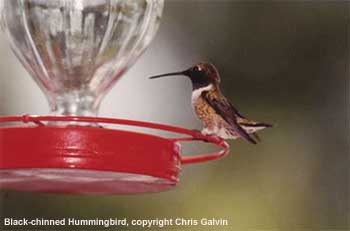
Day 11: And what a storm it was. Our last night at Neal's and we were treated to a spectacular light show and the noisiest thunder I have ever experienced. The lightning was so intense it seemed as if the gods were having a rave party and had left their strobe light on. We were also lashed with what seemed several inches of heavy rain. The storm must have lasted nearly 2 hours. The thunderclaps were overhead and surely there must have been a lightning strike close to where we were staying. The previous evening at dinner we had been informed of a site for both Yellow-headed Blackbird and Dickcissel. We tried for both of these birds at the start of our journey back towards Houston and the coast. Yellow-headed Blackbird was easy and we got close up views of one bird in a roadside bush, Dickcissel, however, would prove to be a dip for the whole trip. It was a long day in the vans today and I think both Vaughan and I made it worse, Vaughan with his incessant puns and me with my out of tune singing. It was a Sunday though and the traffic was light. Our first stop was the Attwater Reserve, and because it was Sunday the reserve was closed! The reserve is only open during the week, closed at weekends. Imagine that at Titchwell. Unlike Titchwell the birding here was quite hard. It is a vast area of coastal prairie and difficult to work. On arrival we all scanned the skies for the outside chance of seeing Bald Eagle. We had a few false calls but no Bald Eagle. We had neither sight nor sound of the endangered Attwater Prairie Chicken or Sprague's Pipit. Undeterred we did find an elusive Le Conte's Sparrow. This is an extremely secretive bird and it's plumage so cryptic it is difficult to see even when almost on top of it. After a long day on the road we arrived at Baytown, which was to be our base for the rest of our stay in Texas.
Day 12: An early start to the day for our trip to Anahuac National Wildlfe Refuge, Bolivar Flats and Boy Scout Woods Sanctuary at High Island. First stop, Anahuac. This reserve is famous for its rail species and up to nine species can be found. Common Moorhen, American Coot, Purple Gallinule were the easy birds to connect with. Later we would add Virginia Rail and Sora, however the elusive Black Rail and Yellow Rail were not to be found. King Rail and Clapper Rail would be added to the list but not today. As we entered the motor trail we took road around Shoveler Pond and stopped at The Willows. A Palm Warbler had been mentioned on the notice board at the reserve centre and it was not long before we found it in the top of the trees. A juvenile Yellow-crowned Night-heron was also found skulking in the adjacent pond. Driving around the motor trail we had stunning views of American Bittern, Least Bittern, Swamp Sparrow and it seemed as if there had been a fall of Orchard Orioles, whilst Eastern Kingbirds perched atop fence posts. Shoveler Pond was also home to a large population of Alligators. The lure of the coast and of High Island made our visit to Anahuac an all too brief one.
Next we headed for Bolivar Flats. On the way we found a Common Nighthawk sitting on a log in a roadside field, well-done Jim for spotting that one. At Bolivar we were treated to the spectacle of hundreds of American Avocets on the shoreline. Brown and American White Pelicans were on the sea along with a collection of terns including the American subspecies of Black Tern. Waders/shorebirds were everywhere. Wilson's Plover, Piping and Snowy Plover were on the shore and I particularly enjoyed up close views of Western Sandpiper in amongst the Least and Semi-palmated Sandpipers. The rest of the group went off to look at Horned Lark whilst I stayed and photographed the Western Sandpiper. I felt as if I could have spent the whole day at Bolivar, however we moved on to High Island. I had heard so much about High Island throughout the trip from Peter and Vaughan, so I was really looking forward to it. We all hoped that it was a 'classic fall' year. At Boy Scout Woods, in no time at all, we saw Yellow Warbler, Worm-eating Warbler (this got the rude name treatment from Pat too!), Brown Thrasher, Blue Jay, Blue-headed Vireo and Scarlet Tanager. It all seemed so strange to me sitting in 'The Grandstand' and watching the birds come to drink from the shallow pool. It amazed me the amount of species to be found in a wood of its size. There were also several Yellow-billed Cuckoos in the treetops, however, the star for me was the glorious male Rose-breasted Grosbeak. It seemed though as if today was not to be one of High Island's 'classic fall' days.
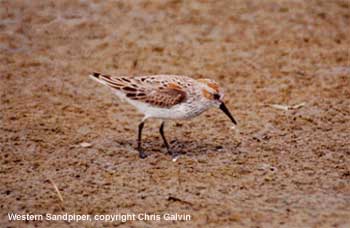
Day 13: Today would be spent in the High Island area all day. Before getting to Boy Scout Woods we would check out some parkland and try for woodpeckers. We also got our second Palm Warbler. Downy and Red-bellied Woodpeckers were picked out amongst the high branches; these birds had replaced the Golden-fronted and Ladder-backed Woodpeckers that we had experienced further south in Texas. Pileated Woodpecker was next. This was an enormous bird and we were treated to watch a bird anting on the roadside. Ever hopeful Vaughan asked 'What colour is the bill?' Ha! Ivory-billed Woodpecker, not. Not content with these 'peckers we also saw a pair of Wood Duck. When we checked into Boy Scout Woods it again had been a quiet morning for migrants, but we did add Gray-cheeked Thrush as well as a very confiding Wood Thrush at Prothonotary Pond. The Yellow-billed Cuckoos were still present but there had not been a new influx of birds that morning. With that news we moved to Smith Oaks.
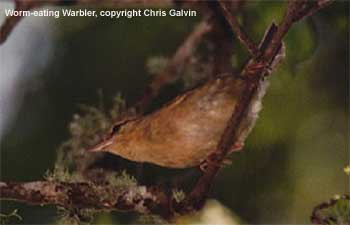
At Smith Oaks the group separated; Alan and I wished to go and photograph the heron rookery whilst the other members of the group went in search of wood warblers. Whilst walking to the rookery Alan and I found two perched Anhingas. These would prove to be the only sightings the group had of this species. Whilst I can appreciate that the Smith Oaks rookery is not the most spectacular in the birding world it is still very worth a visit. Here we could see Great and Snowy Egrets with Black-crowned Night-heron, Tricolored Heron and the beautifully-painted Roseate Spoonbill all at the nest. One pair of Great Egrets had green lores; this is the first time that either Alan or I had ever seen this. We later rejoined the group and had spectacular views of Northern Parula near to where the vans were parked. We went back into Smith Oaks wood and found a perched Eastern Screech Owl. This bird seemed to be much more russet-coloured than the individuals we had seen earlier in the trip. Bay-breasted Warbler was also seen along with Yellow-rumped and more Worm-eating Warblers.
Day 14: This was to be our last full day before our journey back home to the UK. To treat us Vaughan had decided to arrange a 'Rail Walk' at Anahuac. Our quarry was to be the elusive Yellow Rail. When we arrived on site at the reserve we were surprised to see a single Snow Goose. The bird was obviously injured and in a tatty state and had been left behind by the hordes before their northward migration. Although the group had been warned many times of the irritation that Fire Ants could cause, it was here that I would find out for myself. I stood against a gate trying to get a record shot of the Snow Goose and did not realise that I had stood on their nest until it was too late. At least I provided some entertainment for the group. Out on the Yellow Rail prairie we formed a line and walked slowly to see what flew up in front of us. Vaughan was very insistent that we kept in a line and walked at the same pace, this way if anything was flushed we could all see it. He also kept telling everyone to watch his or her footing, guess who was the only person to fall over, yep! Vaughan. We were unsuccessful with Yellow Rail and Black Rail was at best an outside possibility. We did however get great views of Sora, Virginia Rail and King Rail. We would get even better views of Clapper Rail later in the day at Rollover Pass. Back at High Island for the last time and it had proved not to be a 'classic fall' year, well, at least not whilst this group were visiting. A male American Redstart was a frequent visitor to the area of The Grandstand and a family group of Armadillos provided some entertainment as they wallowed in the mud near the pool in front of The Grandstand. It was however a quiet day at High Island (by their standards). It was because of that the group decided to pay another visit to Smith Oaks. I decided to stay put. The group had views of Blackpoll, Black-and-white Warblers and I had had great views of a male Yellow Warbler in the Cathedral. Also present was the Rose-breasted Grosbeak. I was also treated to the sight of an Ovenbird in a tree! This is definitely a place that I would love to visit again.
Day 15: Today was our departure day. Our flight however was not until 4:30 that afternoon so that still left us with some time to do some birding in the morning. We visited W.G. Jones State Forest. This is a mixed pine wood forest and a reliable site for Red-cockaded Woodpecker, Red-headed Woodpecker and also for Brown-headed Nuthatch. Whilst we were searching for these we found a pair of nesting Wood Duck, and also Pine Warbler. All the woodpeckers were picked up after a long search, however Brown-headed Nuthatch proved to be more elusive and need additional searching. I found a White-breasted Nuthatch whilst wandering off on my own, I called the rest of the group over to show them but only Barry got an acceptable view of the bird. The temperature was rising and the rest of the group really wanted to see Brown-headed Nuthatch. I went back to the van and was called out later when the group finally saw the bird. I declined their invitation. Near the Administration Centre there was a nest box out in the middle of a small paddock and a pair of Eastern Bluebirds occupied it. The end of a truly wonderful birding holiday.
On a personal note I would like to thank some members of the group for making my time in Texas a really enjoyable holiday. I would like to thank Irene Knight for her incredible vision and ability to pick out birds that no one else had seen. Pat for her wicked sense of humour and for sharing my Budweiser. Stephen Branch for his laid-back approach and his offer to lend me his tripod when mine had broken, cheers mate. Trevor for his endless quest to find a souvenir pen for 'our Wend.'. Neil for his wayward sense of direction and some of the funniest ever instructions for finding 'his' birds. Jim Wakenshaw for teaching me how to tie a bandana. Who could forget Martin Jaggers and his ice cool dry wit? Stephen Moore for putting up with us all. A special thanks goes to Peter Basterfield for his photography tips and his tips on how to differentiate between different species. I will always think of a Field Sparrow of having pink lipstick on. Thanks to Alan for his cartoons and for not snoring in the evening. For anybody thinking of using Birdfinders for this or any other trip then I cannot recommend Vaughan Ashby too highly. His attention to detail in the preparing of the trip was superb. He works extremely hard whilst on site and ensures that anybody who has not seen any of the target birds does get to see them. Thanks Vaughan.